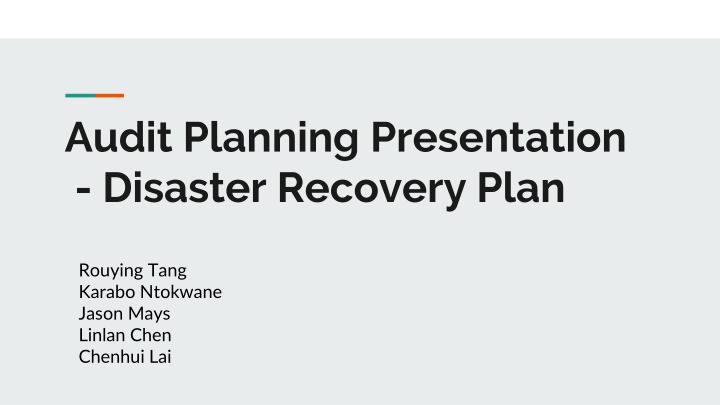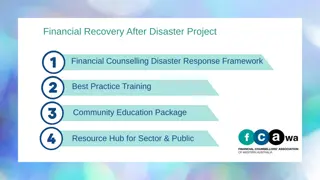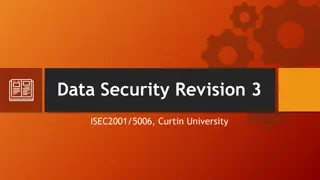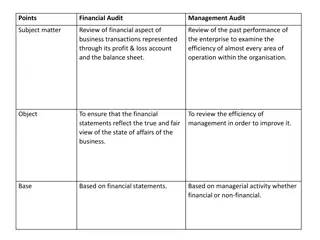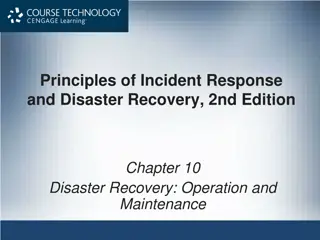Disaster Recovery Plan Audit for Berry College
Berry College's Information Technology Disaster Recovery Plan is a vital strategy to ensure the continuity of IT operations in the event of a disaster. This audit plan presentation outlines the objectives, scope, and responsibilities involved in auditing and maintaining the effectiveness of the disaster recovery plan for Berry College.
Download Presentation

Please find below an Image/Link to download the presentation.
The content on the website is provided AS IS for your information and personal use only. It may not be sold, licensed, or shared on other websites without obtaining consent from the author.If you encounter any issues during the download, it is possible that the publisher has removed the file from their server.
You are allowed to download the files provided on this website for personal or commercial use, subject to the condition that they are used lawfully. All files are the property of their respective owners.
The content on the website is provided AS IS for your information and personal use only. It may not be sold, licensed, or shared on other websites without obtaining consent from the author.
E N D
Presentation Transcript
Audit Planning Presentation - Disaster Recovery Plan Rouying Tang Karabo Ntokwane Jason Mays Linlan Chen Chenhui Lai
Agenda Background & Objectives Scope Risk Assessment Roles and responsibilities Resource Allocation Timeline
Background Written disaster recovery plan: refers to a coordinated strategy involving plans, procedures, and technical measures that enable the recovery of information systems, operations, and data after a disruption. Written disaster recovery plan Auditing: A key step provides instructions, recommendations, and considerations to make sure organization can recover data and continue operations. Should be audited periodically
Background Berry College: An independent, coeducational college founded in 1902 provides comprehensive and balanced education and firsthand educational experience for approximately 2100 students. The current Information technology disaster recovery plan has been reviewed and appareled on December 7th, 2012.
Objectives As the guide for Berry College Office for Information Technology management and staff in the recovery and restoration of the information technology systems operated by OIT in the event that a disaster destroys all or part of those systems 1. To minimize the effects of a disaster and allow the college to either maintain or quickly resume mission-critical functions 2. To protect Berry s computing resources and employees, 3. To safeguard the vital records of which the Office for Information 4. To guarantee the continued availability of essential IT services. 5. To document the procedures for responding to a disaster that involves the data center and OIT services.
Objectives To validate that a disaster recovery plan has been developed, examine its adequacy and effectiveness and ensure that tests have been scheduled to prepare for potential declared disaster.
Scope Disaster declaration RPO and RTO Application recovery priorities Communication plan Responsibilities of members of DR management team Training. Review test plans and reports
Out of Scope Backup procedures Alternative site operation/data center rebuild
Risk assessment Risk will be assessed in 3 security objective areas of Confidentiality | Integrity | Accessibility Risk will be assessed on 3 levels of potential impact Low | Medium | High Personal Identifiable Information (PII) will be given additional consideration using PII confidentiality impact level factors Identifiability | Quantity | Data Field Sensitivity | Context of Use Obligation to Protect | Access to and Location Defined by FIPS Publication 199 & 199 NIST Special Publication 800-34 Rev. 1
Key Risk Areas and Risk Rating High Recovery Time Objectives (RTO) and Recovery Point Objective (RPO) do not meet the Maximum Tolerable Downtime (MTD) noted in the BIA for network service and data protection Distribution of the Disaster Recovery Plan Ability to communicate effectively during disaster Application recovery priorities
Key Risk Areas and Risk Rating Moderate IT Disaster Recovery Management Team understanding of responsibilities Effective training of team participants who are required to execute plan segments in the event of a disaster. Communication between DR Coordinator, Command Center, Team leaders and team members.
Key Risk Areas and Risk Rating Low Review of test plans and reports Disaster declaration process
Prior Findings | Major Changes | Significant Projects Prior Findings | Major Changes There are no prior findings or significant changes to the disaster recovery process or document expected to affect the audit. Significant Projects There is a current project to implement a new offsite backup facility. Completion may occur during the audit. While the site is out of scope it may cause an update in responsibilities and processes within scope.
IT Audit team members roles and responsibilities in this audit Name Roles Responsibilities Chenhui Lai Team Leader 1. 2. Review test plans and reports. Responsible for the overall coordination of the disaster recovery process. Jason Mays Senior Auditor 1. 2. 3. Planning. Data analysis. Verifying vendor contact rosters. Karabo Ntokwane Senior Auditor 1. 2. Reporting. Schedule team leaders for recovery plan communications test. Record results of recovery plan communications test. 3.
IT Audit team members roles and responsibilities in this audit Name Roles Responsibilities Linlan Chen IT Auditor 1. 2. Be the liaison to upper management Planing Rouying Tang IT Auditor 1. 2. 3. Be the liaison to upper management Back up Testing
Audit hours for planning, testing, reporting phases The table below is time allocation for the internal auditing process. Time allocated to each step of auditing Name Total hours Planning Testing Reporting Chenhui Lai 108 hours 72 hours 30 hours 6 hours Jason Mays 74 hours 72 hours 1 hour 1 hour Karabo Ntokwane 114 hours 96 hours 6 hour 12 hour 83 hours 72 hours 10 hour 1 hour Rouying Tang 24 hours 1 hour 1 hour 26 hours Linlan Chen
Citation Abram, Bill (14 June 2012). "5 Tips to Build an Effective Disaster Recovery Plan". Small Business Computing. Retrieved 9 August 2012. https://www.ibm.com/support/knowledgecenter/en/ssw_ibm_i_73/rzarm/rzarmdisastr.htm http://www.all.net/books/audit/kits/bkrecpgm.html National Institute of Standards and Technology (NIST) Contingency Planning Guide for Federal Information Systems Special Publication 800-34 Rev.1.
